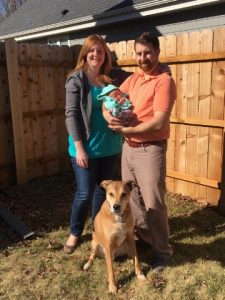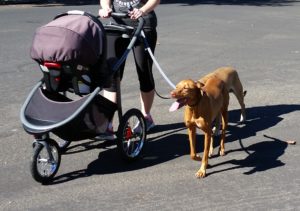During this time of shelter-in-place, you’re spending a lot more time together as a family. Most of the extra time together is good, but there may be some negative consequences as new routines are being established. Recently I was informed of an incident involving a family dog biting a five year old child who crawled into the dog crate while the dog was sleeping. After hearing this, I thought it would be a good time to talk about how some of these new daily routines could impact your child and dog. Let’s help educate your child about making good decisions with the family dog, and avoid potentially bad incidents like a bite.
Children who are normally gone for many hours of the day, expending energy at school, are now spending their days at home. The routine for the dog is probably different too. They may not have as much time to rest as usual, and there is constant sound and movement in the house from family members. Some dogs may love the extra family around, but others may not.
All this extra togetherness just increases the likelihood of a potential incident happening. Supervision is always important when it comes to dogs and kids, but realistically you just can’t watch everything all the time. So what else can you do? Try taking some time to establish clear boundaries and rules with your children regarding your dog(s). Looking back on the incident with the young child mentioned earlier, it’s likely that the dog was startled while asleep and reacted. It could also be that the dog was protecting its space. It’s difficult to prevent all bad things from happening, but this is a good time to be proactive with basic child/dog safety tips.
If your child is old enough to have a conversation, go over some basic tips to help your child learn when to give space and undisturbed rest time to the dog. Space should always be given when a dog is eating and sleeping. Don’t assume your child knows all of the basics. If you need a simple child/dog safety tool that covers many of the basic tips, the Stop, Look & Paws sticker set, that was designed for parents to use with children, can be a big help. It’s also something fun for your child, because they get to sort 12 reusable dog stickers into safe-to-pet or not-safe-to-pet sections on a game board.
So, take some time to sit with your child and review basic safety tips with the family dog. If you need some help, you can read some of the Kids-n-K9s.com blogs and/or get a Stop, Look & Paws sticker set. Enjoy the extra family time and be safe!


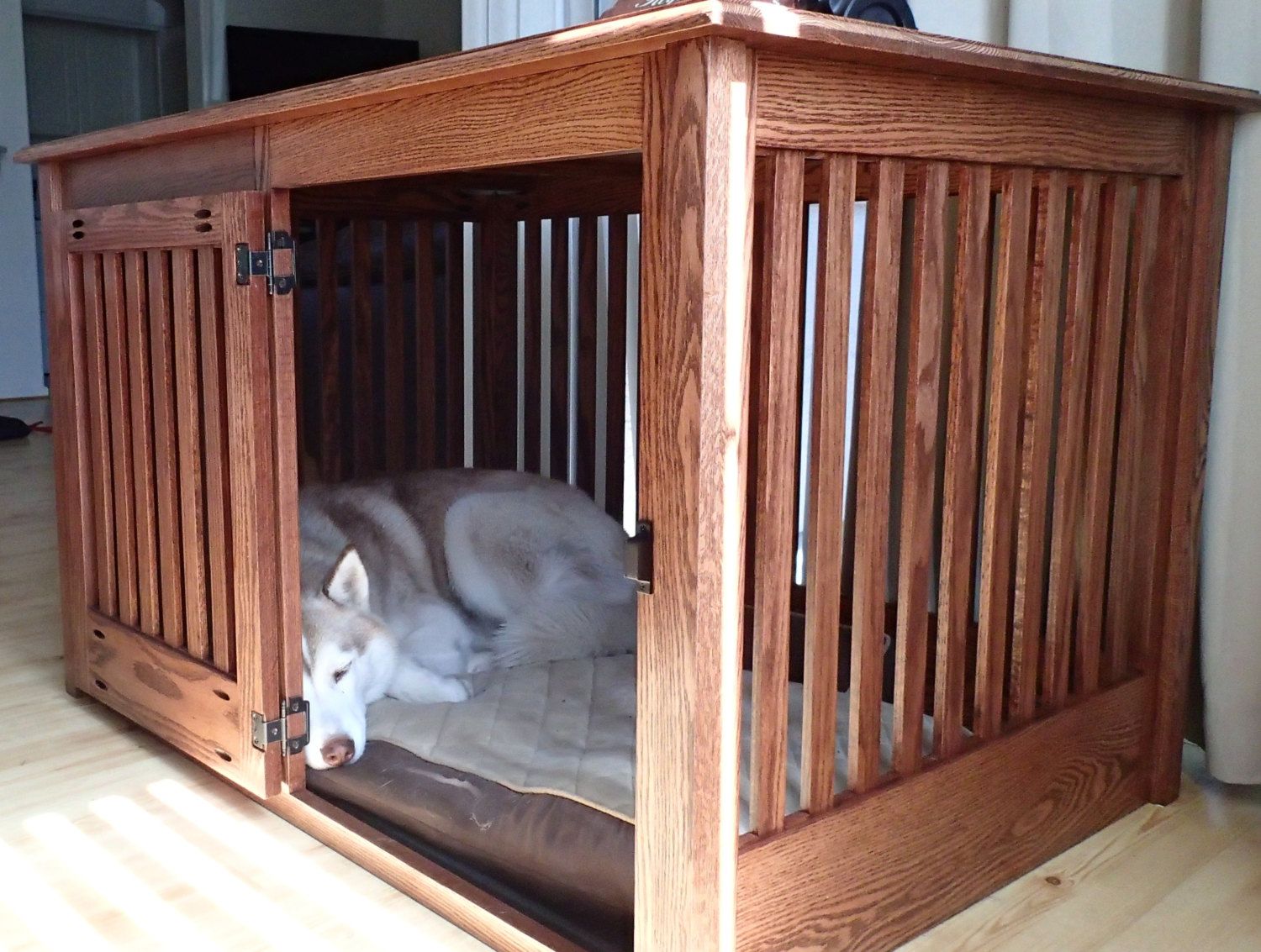
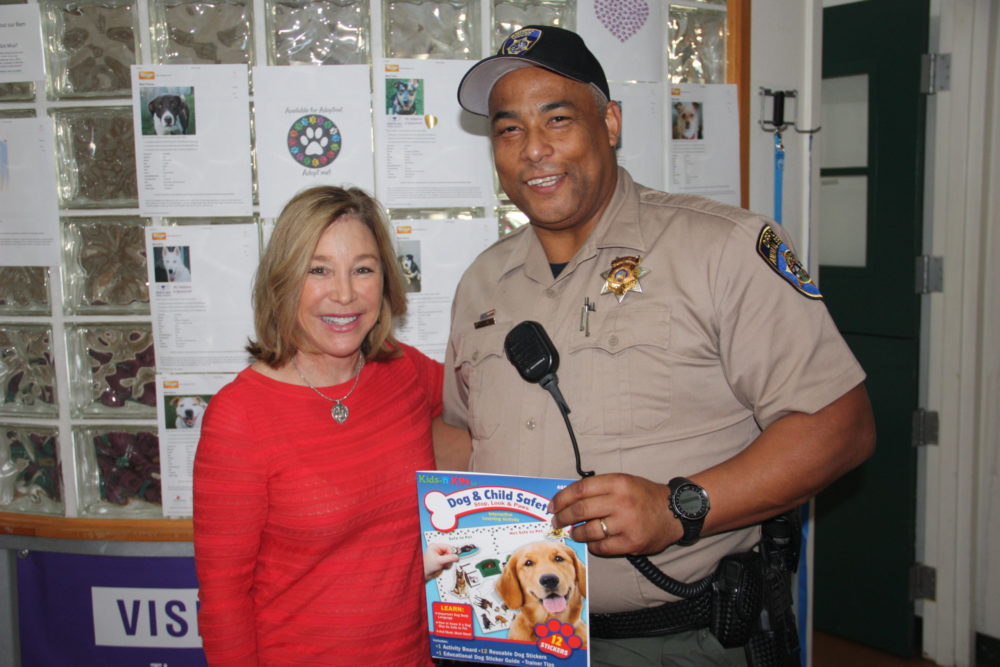
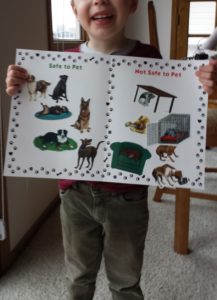 In January 2020, North Bay Animal Services, Petaluma’s local animal shelter, became aware of the current word that Kids-n-K9s was doing in Petaluma and asked to be a sponsor for the kids-n-k9s dog safety campaign that originally began in 2017. This is very crucial because as of December 2019, even with the help of local businesses, I only had half of the schools sponsored for the children to receive Stop, Look & Paws sets free of charge. As I have mentioned, It is very important that in addition to my visits to the classrooms, the children get the learning activity to take home to their parents to play and learn together. If parents don’t have the same safety information to support the decisions that their children make when interacting with dogs, children will continue to get bitten.
In January 2020, North Bay Animal Services, Petaluma’s local animal shelter, became aware of the current word that Kids-n-K9s was doing in Petaluma and asked to be a sponsor for the kids-n-k9s dog safety campaign that originally began in 2017. This is very crucial because as of December 2019, even with the help of local businesses, I only had half of the schools sponsored for the children to receive Stop, Look & Paws sets free of charge. As I have mentioned, It is very important that in addition to my visits to the classrooms, the children get the learning activity to take home to their parents to play and learn together. If parents don’t have the same safety information to support the decisions that their children make when interacting with dogs, children will continue to get bitten.
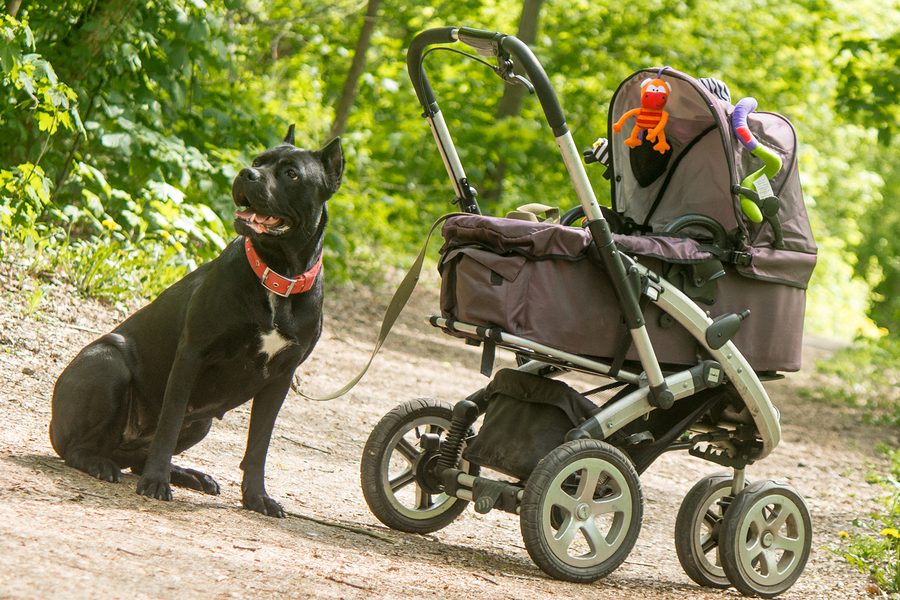
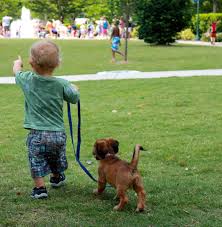
 Overall, be sure to do some of the activities your dog enjoys every day, and importantly, include the baby. For example, a dog walk with the baby stroller is an excellent activity. The dog sees everyone walking as a pack unit, with the baby in the lead. Plus, walking is very healthy for everyone!
If you play games like fetch, the baby can be present as you are playing with the dog. Also, if you play indoor scent games like searching for hidden dog treats, your baby can be present for this as well. Try to find as many things as possible that you can still do where your dog sees that the baby is included.
Overall, be sure to do some of the activities your dog enjoys every day, and importantly, include the baby. For example, a dog walk with the baby stroller is an excellent activity. The dog sees everyone walking as a pack unit, with the baby in the lead. Plus, walking is very healthy for everyone!
If you play games like fetch, the baby can be present as you are playing with the dog. Also, if you play indoor scent games like searching for hidden dog treats, your baby can be present for this as well. Try to find as many things as possible that you can still do where your dog sees that the baby is included.
 Of note, even practicing the basic commands your dog knows, followed by praise and a treat, while your baby is in your arms, makes the dog see the baby as part of the interaction and training. In the eyes of the dog, “Good things happen when the baby is present!”
Two final precautionary thoughts –
1. If you think your dog is showing signs of jealously, please contact a professional trainer to help you. It is usually a situation that can be helped by having the owner make changes in the way they are relating to the dog.
2. Most important, because things can happen in a split second, always supervise your dog and baby when they are together!
It is a wonderful experience for a child to grow up with a dog. Learning to have compassion and understanding of a different species starts with you, and how you model respect and kindness to your canine family member. Enjoy your new family!
Lesley Zoromski
Kids-n-K9s.com
Of note, even practicing the basic commands your dog knows, followed by praise and a treat, while your baby is in your arms, makes the dog see the baby as part of the interaction and training. In the eyes of the dog, “Good things happen when the baby is present!”
Two final precautionary thoughts –
1. If you think your dog is showing signs of jealously, please contact a professional trainer to help you. It is usually a situation that can be helped by having the owner make changes in the way they are relating to the dog.
2. Most important, because things can happen in a split second, always supervise your dog and baby when they are together!
It is a wonderful experience for a child to grow up with a dog. Learning to have compassion and understanding of a different species starts with you, and how you model respect and kindness to your canine family member. Enjoy your new family!
Lesley Zoromski
Kids-n-K9s.com 
 Don’t feel bad, dogs have an amazing sense of smell and good hearing, so they will be able to smell and hear the new baby, even at a distance. This will help them to adjust, and you can observe how your dog reacts.
As I mentioned earlier, you do not want any surprises from your dog. Once you are comfortable with how your dog is reacting, you have the option of inviting them closer.
Dogs may perceive babies as very different compared to adults. Because each dog’s personality is unique, take the time to observe your dog. Does he look anxious, curious, happy or overly excited? Occasionally some dogs may get distressed or overly excited when they hear a baby cry, while others will completely ignore the sounds. If you see anxious or excited behavior, have your dog “Go to their spot” on a dog bed or in their crate. Taking away your dog’s choices and making a decision for him will actually help him relax. Now, he just has to focus on staying in his spot or crate.
Don’t feel bad, dogs have an amazing sense of smell and good hearing, so they will be able to smell and hear the new baby, even at a distance. This will help them to adjust, and you can observe how your dog reacts.
As I mentioned earlier, you do not want any surprises from your dog. Once you are comfortable with how your dog is reacting, you have the option of inviting them closer.
Dogs may perceive babies as very different compared to adults. Because each dog’s personality is unique, take the time to observe your dog. Does he look anxious, curious, happy or overly excited? Occasionally some dogs may get distressed or overly excited when they hear a baby cry, while others will completely ignore the sounds. If you see anxious or excited behavior, have your dog “Go to their spot” on a dog bed or in their crate. Taking away your dog’s choices and making a decision for him will actually help him relax. Now, he just has to focus on staying in his spot or crate.
 Even though you have created some boundaries between the dog and the baby, you can still have your dog feel included. For instance, if the baby is on the floor on a baby blanket, the dog can still be present, lying next to the blanket. Be sure to use the “stay off” command, as mentioned in Part 2, so your dog respects the baby’s space. You want your dog to think that if they stay off the blanket, they will be included in the family fun.
The same advice applies if you are holding, dressing, nursing or feeding the baby – start with a boundary limit to see how it goes first. Have your dog a few feet away, and ultimately, he may be able to lie at your feet as you tend to the baby. Remember to quietly, verbally praise your dog if you see him doing a great job at being calm and relaxed.
How soon you make changes to the boundary distance really depends on your dog. This can happen in a day or two, or it can take longer. You are looking for your dog to be very calm, in control, and polite. You can invite the dog to come over for a sniff of the baby’s toes as a starting point for the first introduction. If the baby reaches to touch the dog, be sure you are touching your dog at the same time to calm them.
Even though you have created some boundaries between the dog and the baby, you can still have your dog feel included. For instance, if the baby is on the floor on a baby blanket, the dog can still be present, lying next to the blanket. Be sure to use the “stay off” command, as mentioned in Part 2, so your dog respects the baby’s space. You want your dog to think that if they stay off the blanket, they will be included in the family fun.
The same advice applies if you are holding, dressing, nursing or feeding the baby – start with a boundary limit to see how it goes first. Have your dog a few feet away, and ultimately, he may be able to lie at your feet as you tend to the baby. Remember to quietly, verbally praise your dog if you see him doing a great job at being calm and relaxed.
How soon you make changes to the boundary distance really depends on your dog. This can happen in a day or two, or it can take longer. You are looking for your dog to be very calm, in control, and polite. You can invite the dog to come over for a sniff of the baby’s toes as a starting point for the first introduction. If the baby reaches to touch the dog, be sure you are touching your dog at the same time to calm them.
 Continue to praise your dog if he makes great choices on his own, like lying quietly or maybe playing with one of his toys. Dogs, like humans, like their efforts to be rewarded. If you reinforce behaviors that you like, they will tend to repeat that behavior.
Once this initial stage of meeting is over, and you have set limits and rules for your dog, you are ready to move on to building the bond between your dog and your baby. That is the topic of my next post.
Lesley Zoromski
Kids-n-K9s.com
Continue to praise your dog if he makes great choices on his own, like lying quietly or maybe playing with one of his toys. Dogs, like humans, like their efforts to be rewarded. If you reinforce behaviors that you like, they will tend to repeat that behavior.
Once this initial stage of meeting is over, and you have set limits and rules for your dog, you are ready to move on to building the bond between your dog and your baby. That is the topic of my next post.
Lesley Zoromski
Kids-n-K9s.com 

 Sharpen up “come” command. The last thing you need when you are trying to do so many additional things in a busy household or rush off to an appointment is to have your dog ignoring you when you are calling them to come to you. This is a super important command to reward so be sure you praise/or treat your dog consistently each time they reach you.
Practice calling them to “come” every time you’re calling your dog for their meal. That is always positive for a dog!
A good solid “stay”, can be so valuable in many areas of your life with the dog especially when you are answering a door or carrying the baby from one room to the next. You don’t want a dog getting under foot.
Sharpen up “come” command. The last thing you need when you are trying to do so many additional things in a busy household or rush off to an appointment is to have your dog ignoring you when you are calling them to come to you. This is a super important command to reward so be sure you praise/or treat your dog consistently each time they reach you.
Practice calling them to “come” every time you’re calling your dog for their meal. That is always positive for a dog!
A good solid “stay”, can be so valuable in many areas of your life with the dog especially when you are answering a door or carrying the baby from one room to the next. You don’t want a dog getting under foot.
 Practice teaching your dog to go to their bed. This is the “go to your spot” and “stay in your spot” command. The goal is to have them stay until you return to release them. Practice in advance so you are prepared for when the baby first arrives. If you haven’t perfected the solid stay with distractions, putting them on leash, or tethering them to a solid object can help. If your dog is crate trained, using a crate is another good option to control your dog when people arrive at your home, or use a baby gate to control their access to rooms.
Practice teaching your dog to go to their bed. This is the “go to your spot” and “stay in your spot” command. The goal is to have them stay until you return to release them. Practice in advance so you are prepared for when the baby first arrives. If you haven’t perfected the solid stay with distractions, putting them on leash, or tethering them to a solid object can help. If your dog is crate trained, using a crate is another good option to control your dog when people arrive at your home, or use a baby gate to control their access to rooms.
 “Stay out” can be used at the door of the baby’s room. Your dog will be happy to watch things from the doorway. If in the future you decide your dog is calm enough to come in, you can always allow it later. If this is initially difficult to do, use a baby gate at the doorway. Your dog can see what is happening but stay at a distance.
If your dog decides not to “stay out”, you can use “get back” to help them stay out of baby’s room, and learn that it’s off limits. If they “get back” and then “stay out”, they won’t get into the diaper pail, which for one of my dogs is like going to a 5 Star restaurant! “Get back” is also good to use if your dog is crowding you and not giving you space when sitting with the baby. Then you can ask for a “down” next to you so they can be close, but not too demanding with your space.
“Wait” is just a good command to use to teach your dog they have to wait for things. It may be for dinner, leaving their crate, or going out the door for a walk. It helps to teach a dog how to have discipline. It can also help keep things calm, and calmness around a baby is a good thing!
“Stay out” can be used at the door of the baby’s room. Your dog will be happy to watch things from the doorway. If in the future you decide your dog is calm enough to come in, you can always allow it later. If this is initially difficult to do, use a baby gate at the doorway. Your dog can see what is happening but stay at a distance.
If your dog decides not to “stay out”, you can use “get back” to help them stay out of baby’s room, and learn that it’s off limits. If they “get back” and then “stay out”, they won’t get into the diaper pail, which for one of my dogs is like going to a 5 Star restaurant! “Get back” is also good to use if your dog is crowding you and not giving you space when sitting with the baby. Then you can ask for a “down” next to you so they can be close, but not too demanding with your space.
“Wait” is just a good command to use to teach your dog they have to wait for things. It may be for dinner, leaving their crate, or going out the door for a walk. It helps to teach a dog how to have discipline. It can also help keep things calm, and calmness around a baby is a good thing!
 “Sit or down” can be used to help make a dog calmer for petting, but this is only if they know how to hold this without you repeating yourself over and over again. You want to say it once; they sit and stay in place until released followed by lots of praise!! If your dog stands calmly to be petted, they don’t even need the sit. The most important thing is that they know how to stay calm in the presence of the baby.
“Leave it” can be used if you or the baby drops something. A quick sniff and investigation by your dog is OK. This also can be very useful if your dog likes to take toys or articles of clothing. You don’t want to create a game of “keep away”, but if it happens anyway, you’ll want to teach “give it”.
“Sit or down” can be used to help make a dog calmer for petting, but this is only if they know how to hold this without you repeating yourself over and over again. You want to say it once; they sit and stay in place until released followed by lots of praise!! If your dog stands calmly to be petted, they don’t even need the sit. The most important thing is that they know how to stay calm in the presence of the baby.
“Leave it” can be used if you or the baby drops something. A quick sniff and investigation by your dog is OK. This also can be very useful if your dog likes to take toys or articles of clothing. You don’t want to create a game of “keep away”, but if it happens anyway, you’ll want to teach “give it”.
 One way I use the “off” command is to have a designated baby blanket on the floor that dogs are not allowed on. This gives the baby a chance to have some tummy time, and allows the dog to be a part of it without being in the middle of it. Of course “off” is good for a dog that jumps on people or objects. Basically, the command means get your feet off of what they are touching.
If you don’t have these commands mastered, use your leash and collar to help show your dog. Dogs have unique personalities, including levels of excitement and curiosity. You will have to judge how much guidance or training you need to do with your dog. If you’re unsure, as many new parents/dog owners are, hire a professional to help you!
Your goal should be to maintain calmness and control with your dog. Remember this is all new to them, so it is important to teach them your expectations for their behavior. I like dogs to see what is happening with the baby, but initially keep at a distance until I can see how they are reacting, and they get more familiar and comfortable with the new baby.
That’s all for Part 2 of the blog post. Part 3 is all about “the meet and greet”. I will make suggestions for your dog getting close to the baby to be sure things are safe and pleasant.
Lesley Zoromski
Kids-n-K9s.com
One way I use the “off” command is to have a designated baby blanket on the floor that dogs are not allowed on. This gives the baby a chance to have some tummy time, and allows the dog to be a part of it without being in the middle of it. Of course “off” is good for a dog that jumps on people or objects. Basically, the command means get your feet off of what they are touching.
If you don’t have these commands mastered, use your leash and collar to help show your dog. Dogs have unique personalities, including levels of excitement and curiosity. You will have to judge how much guidance or training you need to do with your dog. If you’re unsure, as many new parents/dog owners are, hire a professional to help you!
Your goal should be to maintain calmness and control with your dog. Remember this is all new to them, so it is important to teach them your expectations for their behavior. I like dogs to see what is happening with the baby, but initially keep at a distance until I can see how they are reacting, and they get more familiar and comfortable with the new baby.
That’s all for Part 2 of the blog post. Part 3 is all about “the meet and greet”. I will make suggestions for your dog getting close to the baby to be sure things are safe and pleasant.
Lesley Zoromski
Kids-n-K9s.com 
